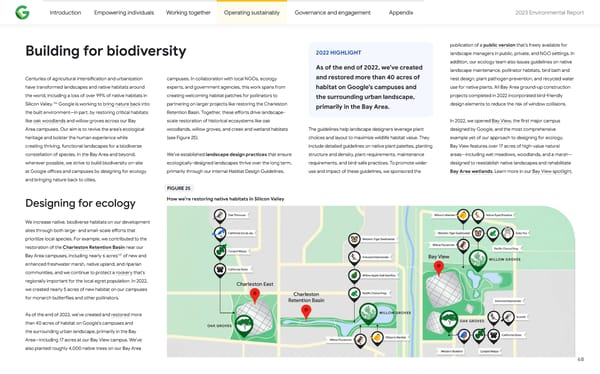Introduction Empowering individuals Working together Operating sustainably Governance and engagement Appendix 2023 Environmental Repo爀琀 publication of a public version that’s freely available for 2022 HIGHLIGHT landscape managers in public, private, and NGO se琀琀ings. In Building for biodiversity addition, our ecology team also issues guidelines on native As of the end of 2022, we’ve created landscape maintenance, pollinator habitats, bird bath and and restored more than 40 acres of Centuries of agricultural intensi昀椀cation and urbanization campuses. In collaboration with local NGOs, ecology nest design, plant pathogen prevention, and recycled water have transformed landscapes and native habitats around expe爀琀s, and government agencies, this work spans from habitat on Google’s campuses and use for native plants. All Bay Area ground-up construction the world, including a loss of over 99% of native habitats in creating welcoming habitat patches for pollinators to the surrounding urban landscape, projects completed in 2022 incorporated bird-friendly 136 Silicon Valley. Google is working to bring nature back into pa爀琀nering on larger projects like restoring the Charleston primarily in the Bay Area. design elements to reduce the risk of window collisions. the built environment—in pa爀琀, by restoring critical habitats Retention Basin. Together, these e昀昀o爀琀s drive landscape- like oak woodlands and willow groves across our Bay scale restoration of historical ecosystems like oak In 2022, we opened Bay View, the 昀椀rst major campus Area campuses. Our aim is to revive the area’s ecological woodlands, willow groves, and creek and wetland habitats The guidelines help landscape designers leverage plant designed by Google, and the most comprehensive heritage and bolster the human experience while (see Figure 25). choices and layout to maximize wildlife habitat value. They example yet of our approach to designing for ecology. creating thriving, functional landscapes for a biodiverse include detailed guidelines on native plant pale琀琀es, planting Bay View features over 17 acres of high-value natural constellation of species. In the Bay Area and beyond, We’ve established landscape design practices that ensure structure and density, plant requirements, maintenance areas—including wet meadows, woodlands, and a marsh— wherever possible, we strive to build biodiversity on-site ecologically-designed landscapes thrive over the long term, requirements, and bird-safe practices. To promote wider designed to reestablish native landscapes and rehabilitate at Google o昀케ces and campuses by designing for ecology primarily through our internal Habitat Design Guidelines. use and impact of these guidelines, we sponsored the Bay Area wetlands. Learn more in our Bay View spotlight. and bringing nature back to cities. FIGURE 25 Designing for ecology How we’re restoring native habitats in Silicon Valley We increase native, biodiverse habitats on our development sites through both large- and small-scale e昀昀o爀琀s that prioritize local species. For example, we contributed to the restoration of the Charleston Retention Basin near our 137 Bay Area campuses, including nearly 6 acres of new and enhanced freshwater marsh, native upland, and riparian communities, and we continue to protect a rookery that’s regionally impo爀琀ant for the local egret population. In 2022, we created nearly 5 acres of new habitat on our campuses for monarch bu琀琀e爀昀lies and other pollinators. As of the end of 2022, we’ve created and restored more than 40 acres of habitat on Google’s campuses and the surrounding urban landscape, primarily in the Bay Area—including 17 acres at our Bay View campus. We’ve also planted roughly 4,000 native trees on our Bay Area 68
 2023 Environmental Report Page 67 Page 69
2023 Environmental Report Page 67 Page 69